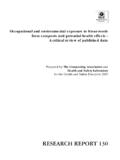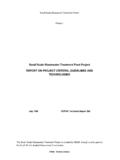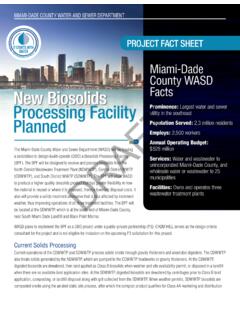Transcription of Bioaerosol emissions from waste composting and the ...
1 Executive Health and Safety Bioaerosol emissions from waste composting and the potential for workers exposure Prepared by the Health and Safety Laboratory for the Health and Safety Executive 2010 RR786 Research Report Executive Health and Safety Bioaerosol emissions from waste composting and the potential for workers exposure Stephen Stagg, Alison Bowry, Adrian Kelsey & Brian Crook Health and Safety Laboratory Harpur Hill Buxton Derbyshire SK17 9JN composting organic waste is an important component of the waste management process in the UK and the strategy to reduce waste to landfill, and as a result there has been an increase in the number of commercial composting operations. Microbiological activity is fundamental to the composting process, therefore any handling of composting material is likely to make airborne significant quantities of those micro-organisms (referred to as bioaerosols). Workers mechanically handling compost on these sites may therefore be at risk of considerable exposure to bioaerosols depending on their work task, their proximity to the Bioaerosol source and the control measures put in place.
2 In addition, because the work is largely done out of doors, there is the potential for bioaerosols generated to disperse some distance from the point source. Consequently, there is concern that people living or working in the vicinity of waste composting sites (sensitive receptors) may also be exposed to these bioaerosols. Bioaerosols were sampled at sites representative of commercial scale waste composting in the UK. The samples taken were linked to specific activities likely to generate compost bioaerosols, such as turning and screening, and samples were collected from as close as possible to the source of emission. The dispersion of bioaerosols from compost handling activities was estimated by collecting Bioaerosol samples at several points downwind increasing in distance from the emission site up to 250m. Upwind background samples were used as a benchmark. The sampling took place during both winter and summer periods to provide an insight into the differences in Bioaerosol generation that may exist.
3 This report and the work it describes were funded by the Health and Safety Executive (HSE). Its contents, including any opinions and/or conclusions expressed, are those of the authors alone and do not necessarily reflect HSE policy. HSE Books Crown copyright 2010 First published 2010 All rights reserved. No part of this publication may be reproduced, stored in a retrieval system, or transmitted in any form or by any means (electronic, mechanical, photocopying, recording or otherwise) without the prior written permission of the copyright owner. Applications for reproduction should be made in writing to: Licensing Division, Her Majesty s Stationery Office, St Clements House, 2-16 Colegate, Norwich NR3 1BQ or by e-mail to ACKNOWLEDGEMENTS The authors would like to thank Environment Agency staff for their help in identifying composting sites to be involved in this study, and the co-operation of composting site staff during site visits. ii CONTENTS 1 1 The composting process and its commercial importance.
4 1 Potential health risks associated with waste 2 HSE funded study on bioaerosols from composting .. 3 2 MATERIALS AND 4 Description of the compost sites included in this 4 Bioaerosol Monitoring And Analyses .. 7 Bioaerosol Sample 10 Identification of Micro-organisms .. 11 Dustiness Testing .. 12 Profiling the Microbial Population of compost .. 14 3 RESULTS .. 15 Bioaerosol sampling individual sites .. 15 Comparison of Bioaerosol data from all sites and stratification of Bioaerosol 29 Summarised data for potential exposure to bioaerosols in and around composting facilities risk zones .. 54 Identification of predominant micro-organisms .. 57 Comparison of Bioaerosol particle size data .. 58 4 61 Evaluation of Bioaerosol sampling and analysis methods 61 Observations on Bioaerosol and dust emission from composting activities at individual sites .. 62 Compost site Bioaerosol emission and 63 Personal and task-specific monitoring of exposure workers in vehicle cabs.
5 66 Comparison of Bioaerosol data from all sites and stratification of Bioaerosol 67 Comparison of compost Bioaerosol emissions with other studies and other 68 5 74 Existing knowledge about bioaerosols from waste composting .. 74 What this study adds to knowledge about bioaerosols from waste composting .. 74 6 APPENDIX 1: Bioaerosol DATA FOR INDIVIDUAL STUDY SITES 77 SITE A VISIT 1: .. 77 SITE A VISIT 2 .. 78 SITE E Visit 1 .. 80 SITE E Visit 2 (MBT Plant) .. 82 SITE B VISIT 1 .. 84 SITE B VISIT 2 .. 86 iii SITE C VISIT 1 .. 88 SITE-C VISIT 2 .. 90 SITE D VISIT 1 .. 92 SITE D VISIT 2 .. 94 SITE D VISIT 3 .. 95 SITE F VISIT 1 .. 97 SITE F VISIT 2 .. 100 7 APPENDIX 2: PHOTOGRAPHS OF SITE 102 Photograph 1. Turning machine at SITE B .. 102 Photograph 2. Turning machine AT SITE C .. 103 Photograph 3. Turning at Site D (also method for SITE A) .. 104 8 APPENDIX 3: SITE 105 SITE PLAN (SITE A)..105 SITE PLAN (SITE B ).
6 105 SITE PLAN (SITE C, ) .. 106 SITE PLAN (SITE D) .. 106 9 107 iv EXECUTIVE SUMMARY Objectives composting organic waste is an important component of the waste management process in the UK and the strategy to reduce waste to landfill, and as a result there has been an increase in the number of commercial composting operations. Microbiological activity is fundamental to the composting process, therefore any handling of composting material is likely to make airborne significant quantities of those micro-organisms (referred to as bioaerosols). Workers mechanically handling compost on these sites may therefore be at risk of considerable exposure to bioaerosols depending on their work task, their proximity to the Bioaerosol source and the control measures put in place. In addition, because the work is largely done out of doors, there is the potential for bioaerosols generated to disperse some distance from the point source.
7 Consequently, there is concern that people living or working in the vicinity of waste composting sites (sensitive receptors) may also be exposed to these bioaerosols. Bioaerosols were sampled at sites representative of commercial scale waste composting in the UK. The samples taken were linked to specific activities likely to generate compost bioaerosols, such as turning and screening, and samples were collected from as close as possible to the source of emission. The dispersion of bioaerosols from compost handling activities was estimated by collecting Bioaerosol samples at several points downwind increasing in distance from the emission site up to 250m. Upwind background samples were used as a benchmark. The sampling took place during both winter and summer periods to provide an insight into the differences in Bioaerosol generation that may exist. Main Findings The results confirmed that, close to the source of composting processes, large concentrations of bacteria, actinomycetes and fungi, and to a lesser extent endotoxin and dust, may be aerosolised.
8 Bacteria and fungi frequently in excess of 100,000 (105) cfu/m3 of air and sometimes in excess of 1 million (106) cfu/m3 air were measured immediately adjacent to the release area (windrow turning). There was a general trend of decreasing Bioaerosol with distance from the source. This is most prominent at 50m distance from the source compared to the immediate area of release (samples taken outside vehicle cabs), and at 10m distance. By 50m and 100m distances downwind of the process, Bioaerosol concentrations were substantially reduced by comparison to those levels measurements at source. For ease of interpretation, the Bioaerosol emission data were subdivided into exposure bands for the four main Bioaerosol components for individual sites and for site activities. A risk zone approach was also applied to the overall emission data for each of the four main Bioaerosol components, to summarise the likelihood of exposure to bioaerosols at different distances from composting activities.
9 In summary: Bioaerosol concentrations at 50m upwind of site operations were within a range considered to be typical background levels, with the large majority (84%+) of samples yielding less than 1,000 cfu/m3 air of bacteria, actinomycetes, fungi and Aspergillus fumigatus. Close to compost handling activities, if workers are not protected from exposure, they may be exposed to concentrations of airborne bacteria and fungi that frequently exceed v 100,000 (105) cfu/m3 and occasionally (28% of bacterial samples and 10% of fungal samples) exceed 1 million cfu/m3 air sampled. Downwind of compost handling activities, although at some sites the Bioaerosol levels at times were higher than upwind even at 100 to 250m distance, still the majority of samples yielded fewer than 1,000 cfu/m3 air. At least 93% of bacteria and 98% of Aspergillus fumigatus Bioaerosol concentrations were less than 5,000 cfu/m3 air, and could be considered to be within the range of typical background levels.
10 There was little evidence therefore that the composting operations studied made a major contribution to the overall Bioaerosol burden by a distance of 250m from activities. Recommendations Bioaerosol emissions from commercial waste composting activities will continue to be a health concern for workers on site and to near neighbours. This study has provided evidence of the potential for compost site workers to be exposed to large concentrations of bioaerosols, and some previous epidemiological studies have examined the effect of such levels of exposure to compost bioaerosols and shown the potential for allergic respiratory ill health. The data from this study has demonstrated that compost Bioaerosol emissions rapidly decline with distance from source and that at site boundaries are within what could be considered as typical background levels. Only limited information exists on the effects of long term exposure to bioaerosols at or slightly above typical environmental levels, and the threshold dose that may trigger respiratory response.

















